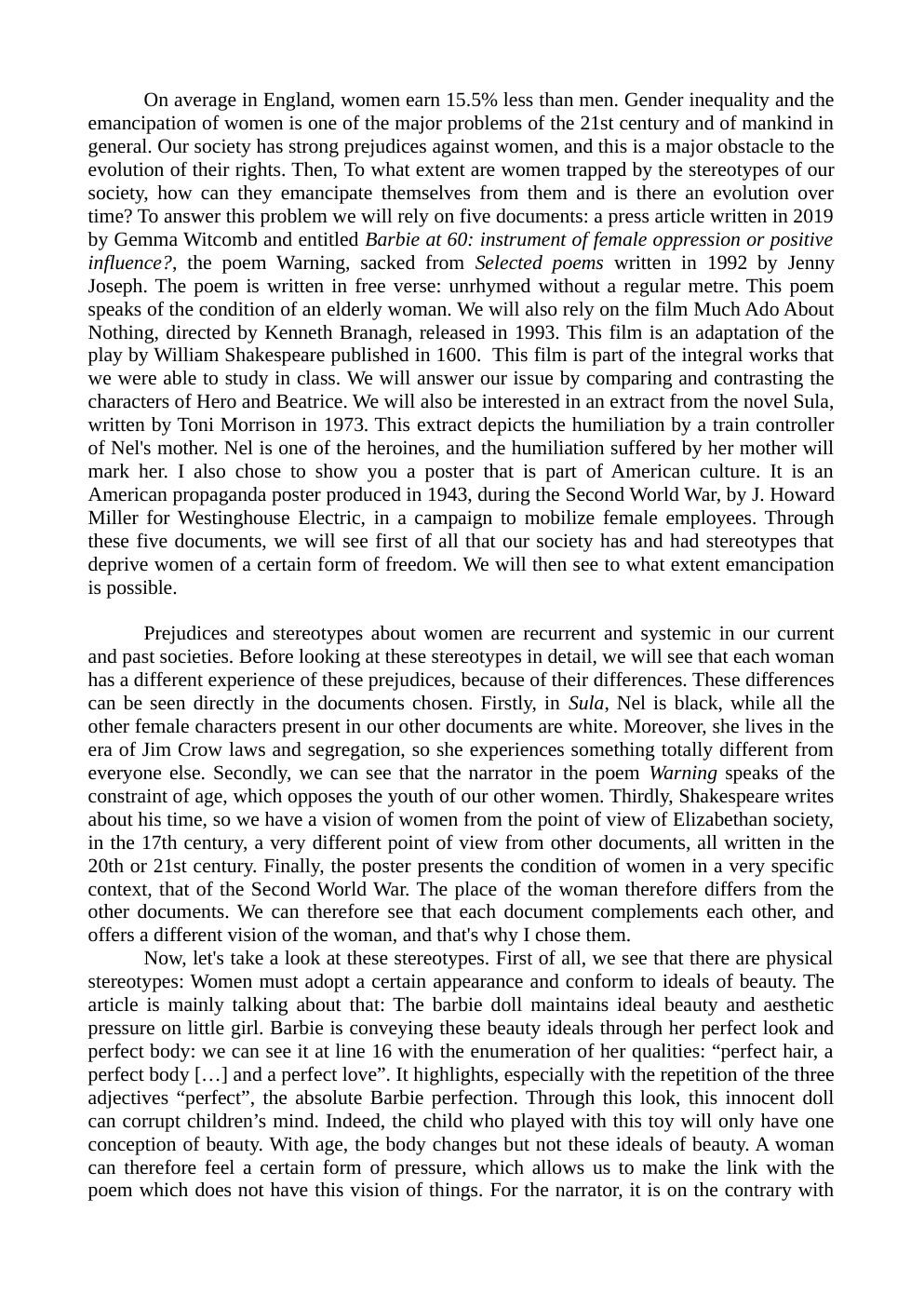Oral de LLCE Anglais - Portfolio
Publié le 27/05/2022

Extrait du document
«
On average in England, women earn 15.5% less than men.
Gender inequality and the
emancipation of women is one of the major problems of the 21st century and of mankind in
general.
Our society has strong prejudices against women, and this is a major obstacle to the
evolution of their rights.
Then, To what extent are women trapped by the stereotypes of our
society, how can they emancipate themselves from them and is there an evolution over
time? To answer this problem we will rely on five documents: a press article written in 2019
by Gemma Witcomb and entitled Barbie at 60: instrument of female oppression or positive
influence?, the poem Warning, sacked from Selected poems written in 1992 by Jenny
Joseph.
The poem is written in free verse: unrhymed without a regular metre.
This poem
speaks of the condition of an elderly woman.
We will also rely on the film Much Ado About
Nothing, directed by Kenneth Branagh, released in 1993.
This film is an adaptation of the
play by William Shakespeare published in 1600.
This film is part of the integral works that
we were able to study in class.
We will answer our issue by comparing and contrasting the
characters of Hero and Beatrice.
We will also be interested in an extract from the novel Sula,
written by Toni Morrison in 1973.
This extract depicts the humiliation by a train controller
of Nel's mother.
Nel is one of the heroines, and the humiliation suffered by her mother will
mark her.
I also chose to show you a poster that is part of American culture.
It is an
American propaganda poster produced in 1943, during the Second World War, by J.
Howard
Miller for Westinghouse Electric, in a campaign to mobilize female employees.
Through
these five documents, we will see first of all that our society has and had stereotypes that
deprive women of a certain form of freedom.
We will then see to what extent emancipation
is possible.
Prejudices and stereotypes about women are recurrent and systemic in our current
and past societies.
Before looking at these stereotypes in detail, we will see that each woman
has a different experience of these prejudices, because of their differences.
These differences
can be seen directly in the documents chosen.
Firstly, in Sula, Nel is black, while all the
other female characters present in our other documents are white.
Moreover, she lives in the
era of Jim Crow laws and segregation, so she experiences something totally different from
everyone else.
Secondly, we can see that the narrator in the poem Warning speaks of the
constraint of age, which opposes the youth of our other women.
Thirdly, Shakespeare writes
about his time, so we have a vision of women from the point of view of Elizabethan society,
in the 17th century, a very different point of view from other documents, all written in the
20th or 21st century.
Finally, the poster presents the condition of women in a very specific
context, that of the Second World War.
The place of the woman therefore differs from the
other documents.
We can therefore see that each document complements each other, and
offers a different vision of the woman, and that's why I chose them.
Now, let's take a look at these stereotypes.
First of all, we see that there are physical
stereotypes: Women must adopt a certain appearance and conform to ideals of beauty.
The
article is mainly talking about that: The barbie doll maintains ideal beauty and aesthetic
pressure on little girl.
Barbie is conveying these beauty ideals through her perfect look and
perfect body: we can see it at line 16 with the enumeration of her qualities: “perfect hair, a
perfect body […] and a perfect love”.
It highlights, especially with the repetition of the three
adjectives “perfect”, the absolute Barbie perfection.
Through this look, this innocent doll
can corrupt children’s mind.
Indeed, the child who played with this toy will only have one
conception of beauty.
With age, the body changes but not these ideals of beauty.
A woman
can therefore feel a certain form of pressure, which allows us to make the link with the
poem which does not have this vision of things.
For the narrator, it is on the contrary with.
»
↓↓↓ APERÇU DU DOCUMENT ↓↓↓
Liens utiles
- oral dossier llce anglais
- Oral LLCE Dossier Spécialité English
- Exemple d'un sujet d'oral de bac de LLCE
- oral llce
- Grand oral llce: Est-il possible de déconstruire les préjugés de notre société afin de se construire soi-même ?


